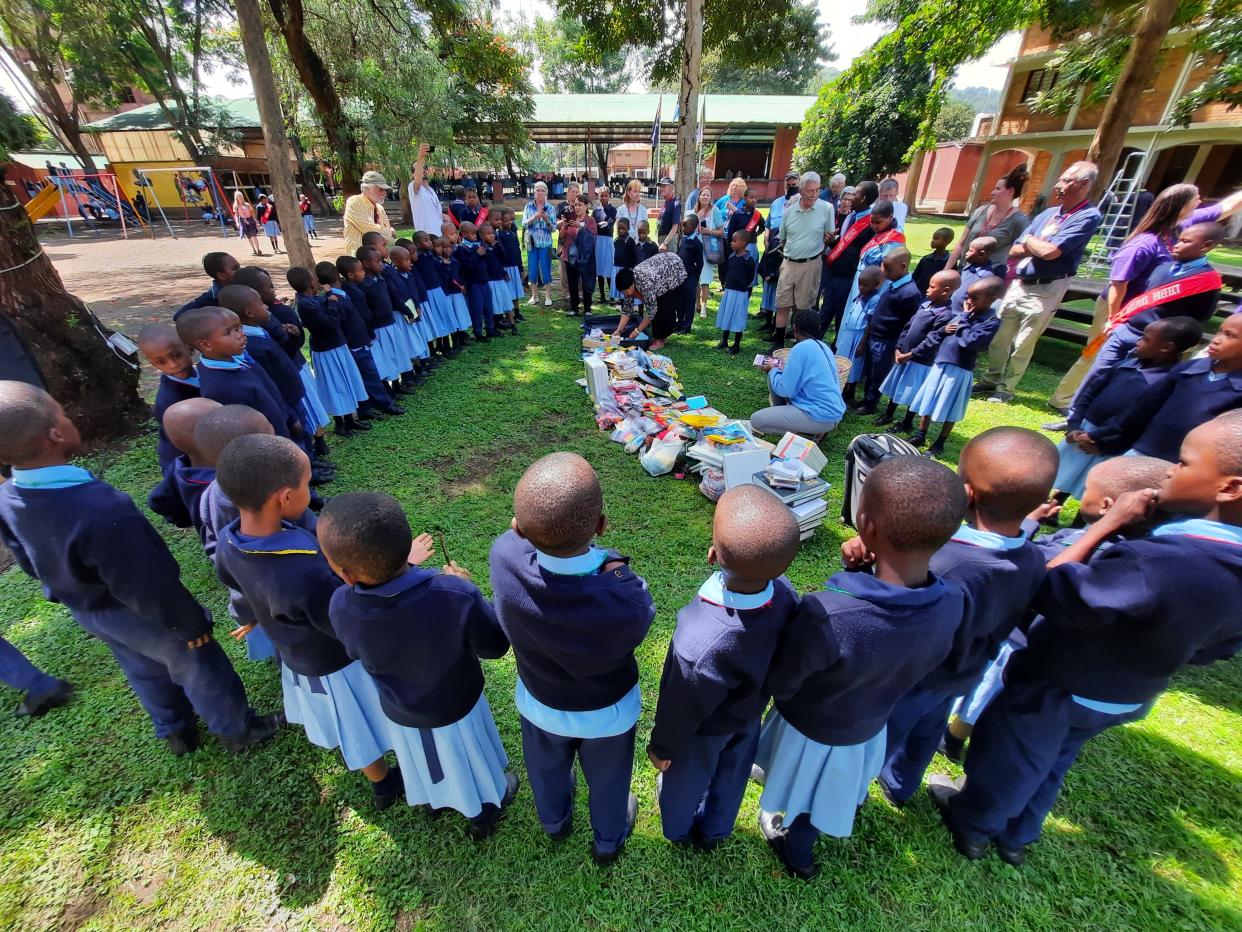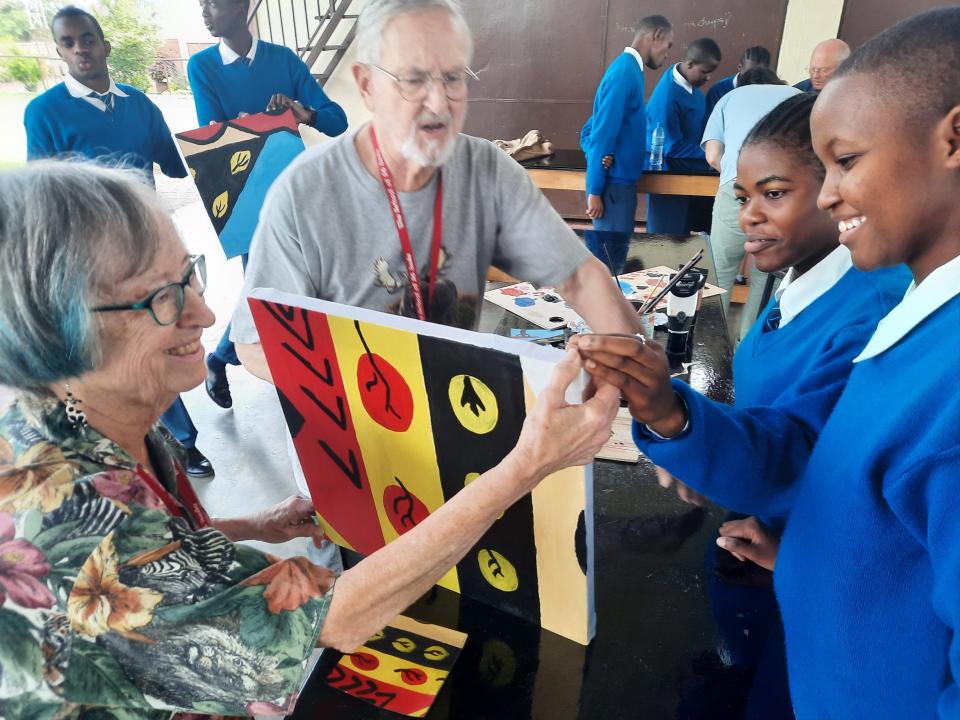South Dakota group visit supports school in Tanzania

Most Americans donate charitably from their abundance but when you receive the gift of one of the only two chickens a family owns it changes your life.
Such was the case in May when three Watertown Rotarians visited the home of their club’s sponsored student at the School of St. Jude in Arusha, Tanzania.
The trio was part of about 35 mostly South Dakota Rotarians and spouses who traveled to Africa to enjoy a photo safari and spend a week at the private school started 20 years ago by an Australian woman.
The week-long Safaris-R-Us trip in the Serengeti Plains, Ngorongoro Crater and Lake Manyara provided a stunning experience with African wildlife. It was one of the first safaris in the area since Covid.
The group then headed for the School of St. Jude, which now educates 1,800 students who are the brightest students from the poorest families.
The school is funded largely by sponsors with connections to Rotary clubs in Australia and the United States. South Dakota’s role in helping build the school is extraordinary.
Tanzania, on Africa’s eastern coast is home to about 66.6 million people. About 80% live on less than $4 a day.
Education is a luxury and most adults average only 5.8 years of school. Only about 28% of Tanzanian students will enter the equivalence of middle school and even fewer graduate high school and about 8% get university degrees.
But the School of St. Jude is a beacon of hope on the edge of Arusha, a city of about 580,000 people.
School founder Gemma Sisia said Tanzania has about 17,500 primary (elementary) schools and less than 800 high schools. Students must take national exams at the end of sixth grade and 10th grade in order to compete for a few higher-level grades.
Often it was the poorer students whose families could not afford government schools that did not continue and Sisia wanted to help the students living in deep poverty.
Sisia’s father first connected her to Australian Rotarians for possible financial help. In 2003 the international Rotary conference was in Brisbane, Australia and Sisia was invited to speak. It was there she met Rapid City Rushmore Club Rotarian Pat Sutliff who was so impressed by Sisia’s efforts that she formed the American Friends of the School of St. Jude foundation so that U.S. Rotary clubs and individuals could sponsor students.
“The Tanzanian school system leaves a lot to be desired,” Sutliff said. “This school gives very poor families a chance to have their children receive an education.”
The Sutliffs have sponsored at least one student for nearly their entire 19-year association with the school “It is amazing to see where these students come from and what they are like when they graduate,” she said. “They are going to make a difference in their country. For us to touch and change other people’s lives on the other side of the world is amazing.”
Admission to the school is very competitive. About 4,000 students including the top 10% from government schools make the first cut. After academic tests, the number may drop to less than 1,000.

School staff then visits the home of each prospective student and if they meet the poverty criteria, they may become one the few hundred eventually admitted. Once admitted the students receive a free education and 80% are housed on campus.
“They are hungry (to learn)” Sisia said of St. Jude students. “They know what a government school is like. Imagine being in a government school not having a teacher half the time. You have to self-teach yourself. You have to really have that determination factor.”
Rotarians on the St. Jude visit were taken to a government school. No education buildings in South Dakota are anywhere as poor as these schools. Some classes can have 60 to 100 students.
So being accepted to St. Jude, where instruction is in English, is similar to winning the lottery.
The school depends on hosting visitors to advance its sponsorship support. Two years of Covid had a negative impact as about 24% of current enrollment is without sponsors.
To build rapport, the U.S. visitors spent time with St. Jude students, enjoying lunches, participating in classes, discussing careers and exchanging culture. They also were honored at the school’s equivalence of high school graduation.
The Rotary visitors also broke into small groups to visit the homes of their sponsored students.
The home visit was “a life changer,” said Tom Johnson, general manager of Karl’s TV, Appliance and Furniture in Sioux Falls. “It is one where you realize the depth of poverty. Even though we have poverty at home, we do not see it to the level of the depth that we do here.
“When you meet a woman who graduated in 2015 and seven years later is a medical doctor who came out of a dirt hut with a straw roof, no running water…it is stories that you hear but until you see it, touch it, smell it that it becomes real.”
Johnson, a member of the Sioux Falls downtown Rotary Club, said it made him re-evaluate his charitable giving.
“We live in such a marvelous world. Somebody said on this trip that the day you were born in America, you won the lottery and that is so true. These people have nothing, but they are happy, and they are fortunate to have a school here that says we believe in you and people around the world support these children from age five or six until they are 20 and educate them to make a difference.”
Sutliff said that making home visits and witnessing the poverty “breaks your heart. But one of the wonderful things is they are so thankful for the education being provided. The kids work really hard to take advantage of what they have been given.”
Former Rotary District 5610 Governor Bert Olson, Sioux Falls, said “The poverty and living circumstances of the majority of the people here are lower than anything I have ever seen in my life.”
On a home visit, the sponsors bring a gift prepared by the school – essential items such as cooking oil, soap and solar lamps as many houses do not have running water or electricity. In return, it is tradition for the family to give a gift to the sponsor.
The gift given by the family of the student sponsored by Watertown’s Rotary club was one of their two chickens.
“When I think about it now, I still cry,” said Watertown Rotarian Wendy Fransen who helps sponsor the student, whose name is Goodluck. “For them to give us half of what they had is so deeply profound. They gave so much when we gave so little. It just brings tears to my eyes.”
Sutliff noted that sponsoring children at the school is not limited to Rotarians. Anyone can help change the world.
“We are all in this world together,” she said, “and it is important to help each other because you as an individual can make a difference.”
This article originally appeared on Watertown Public Opinion: South Dakota group visit supports school in Tanzania

